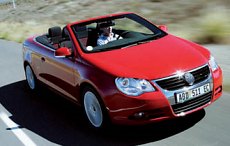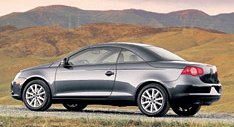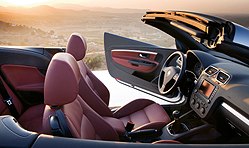|
 Eos
is the Greek Goddess of dawn. Volkswagen uses this romantic name to
represent its first coupe-cabriolet. However, most people know it is
actually a Golf Coupe-Cabriolet. Although no body panels bar the grille
are shared between them, Eos shares the same wheelbase, the same
engines, gearboxes, steering and even the same dashboard with Golf.
Volkswagen would argue that its suspension bits come from Passat, but
what it didn’t say is that the suspensions of Passat were also derived
from Golf’s – the only difference is track width. So, Eos runs wider
tracks than Golf, otherwise it is every bit a Golf Coupe-Cabriolet. Eos
is the Greek Goddess of dawn. Volkswagen uses this romantic name to
represent its first coupe-cabriolet. However, most people know it is
actually a Golf Coupe-Cabriolet. Although no body panels bar the grille
are shared between them, Eos shares the same wheelbase, the same
engines, gearboxes, steering and even the same dashboard with Golf.
Volkswagen would argue that its suspension bits come from Passat, but
what it didn’t say is that the suspensions of Passat were also derived
from Golf’s – the only difference is track width. So, Eos runs wider
tracks than Golf, otherwise it is every bit a Golf Coupe-Cabriolet.
 The engines available include
the familiar 115hp 1.6 FSI, 150hp 2.0 FSI, 200hp 2.0 TFSI turbo, 250hp 3.2 VR6 and 140hp 2.0 TDI turbo
diesel. Transmission could be either 6-speed manual or 6-speed DSG. All
Eos are front-wheel-drive, including the most powerful V6, because the
extra underfloor reinforcement underneath the B and C pillars rob the
space for usual Haldex 4WD system. The engines available include
the familiar 115hp 1.6 FSI, 150hp 2.0 FSI, 200hp 2.0 TFSI turbo, 250hp 3.2 VR6 and 140hp 2.0 TDI turbo
diesel. Transmission could be either 6-speed manual or 6-speed DSG. All
Eos are front-wheel-drive, including the most powerful V6, because the
extra underfloor reinforcement underneath the B and C pillars rob the
space for usual Haldex 4WD system.
Like
Volvo C70 and Opel Astra TwinTop, the Eos employs a more advanced
folding roof consisting of 2 horizontal pieces, 1 rear screen and 2
side frames. This makes the roof more compact to store, thus save the requirement
for an extra-long boot. Besides, the longer horizontal section means
the windscreen does not need to tilt close to the driver's head. The
folding roof mechanism is supplied by Oasys (like Volvo C70). It must
be very expensive, because it is a full-length panoramic glass roof
with a sliding sun roof incorporated – none of its rivals got this
feature. The roof opens and closes by electric motors in 25 seconds.
 While the roof seems more
upmarket than rivals, the cabin is not as spacious as Volvo C70
(admittedly, the latter is more expensive). The short wheelbase of Golf
compromises rear legroom while the upright seatback is uncomfortable.
The chassis reinforcement eats 250mm into the width of the rear seats.
Therefore the rear seats are not suitable for adults for long journey. While the roof seems more
upmarket than rivals, the cabin is not as spacious as Volvo C70
(admittedly, the latter is more expensive). The short wheelbase of Golf
compromises rear legroom while the upright seatback is uncomfortable.
The chassis reinforcement eats 250mm into the width of the rear seats.
Therefore the rear seats are not suitable for adults for long journey.
 The handling and ride
characteristic is typical Volkswagen style – lots of grip, safe and
mild understeer. Eos employs softer springs and dampers than the Golf,
so it rolls more in corners, but rides comfortably. The chassis is
rigid by the standard of coupe-cabriolet. The 2.0 FSI turbo engine
suits the Eos best, as it provides plenty of bottom-end torque to pull
the heavy car, while its superb refinement enhances the relax feel when
the driver is enjoying open air motoring. The handling and ride
characteristic is typical Volkswagen style – lots of grip, safe and
mild understeer. Eos employs softer springs and dampers than the Golf,
so it rolls more in corners, but rides comfortably. The chassis is
rigid by the standard of coupe-cabriolet. The 2.0 FSI turbo engine
suits the Eos best, as it provides plenty of bottom-end torque to pull
the heavy car, while its superb refinement enhances the relax feel when
the driver is enjoying open air motoring.
However, the Eos is not cheap. Like other Volkswagen products, it
charges premium price for the same specifications as its mainstream
rivals. Judging from its high-standard refinement and quality, it may
worth that extra money. Volkswagen used to successfully establish a
niche status for its Golf Cabriolet, so it does not bother to compete
with rivals on price. |